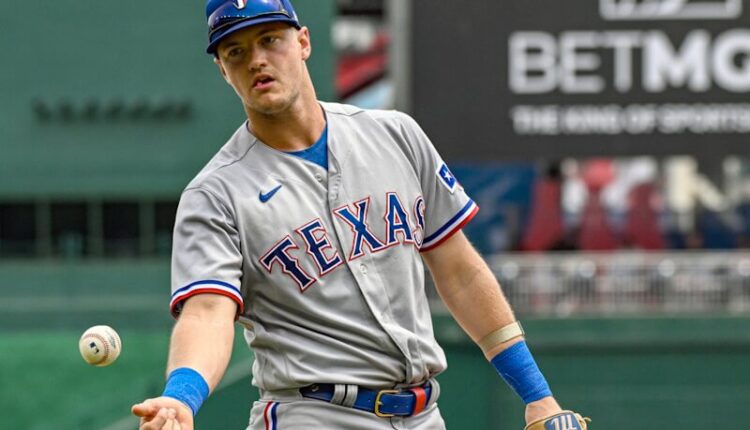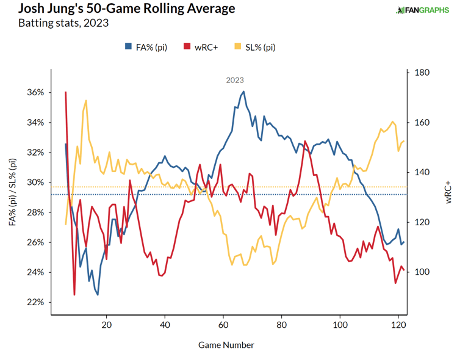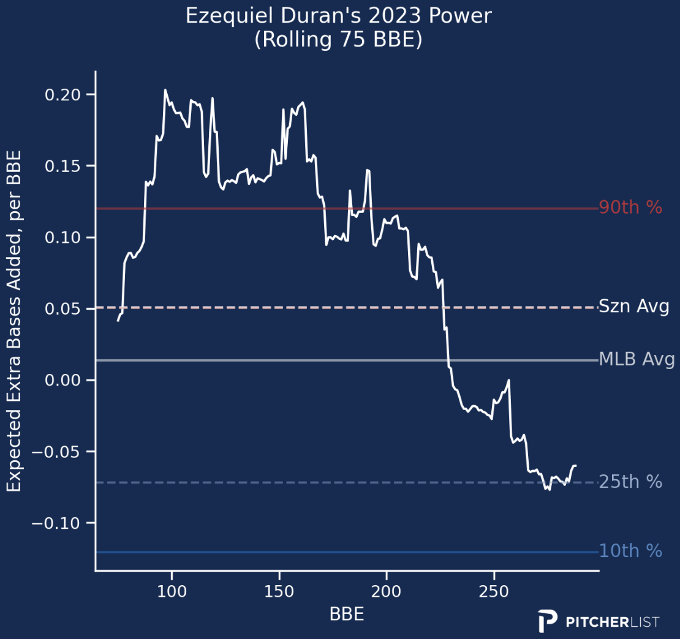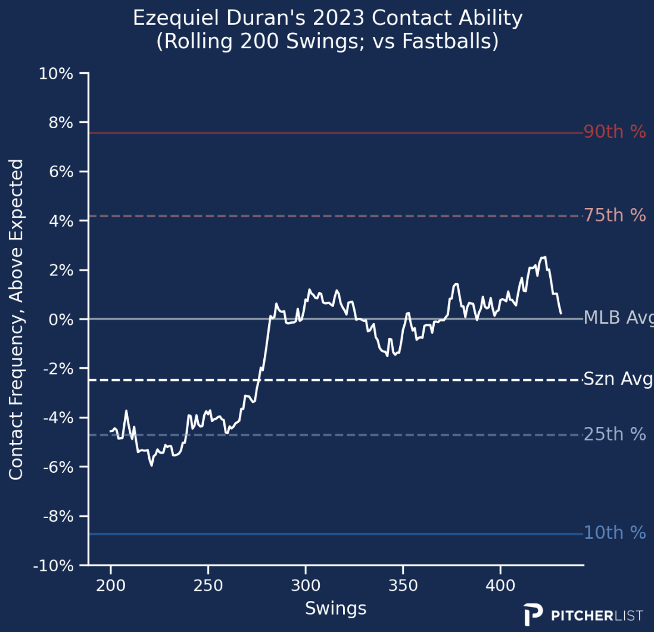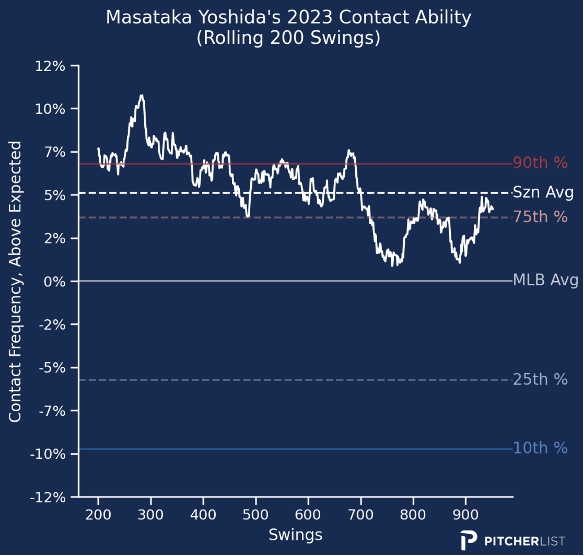One of the most common phrases in sports is, “It is not how you start, but how you finish.” This is often used to motivate teams to push through their early season struggles and come together to get hot at the right time and win the championship. However, nobody likes to talk about what happens when you struggle to end the year. As fantasy baseball players, how a player performs during the second half is more relevant in our brains as we begin preparing for the next season. A few weeks ago, I looked at four players who saw their stock rise during the second half. This article looks at four players who struggled during the back half of the season and evaluates how fantasy managers should value these players in 2024.
4 Players Who Struggled in the Second Half of 2023
Josh Jung- 3B, TEX
The First Half
As Gunnar Henderson stumbled a bit out of the gates, the early favorite for American League Rookie of the Year was Josh Jung. A rough 2022 debut dampened the optimism surrounding the former top prospect, but he seemed to bounce back in a major way. After going 1/10 in the first two games of the season, Jung caught fire. From April 2 through the end of the first half, Jung slashed .283/.332/.513. His strikeout rate (which was a concern entering the season) was down to 27.9%. Still a high strikeout rate, but much more manageable.
Jung was having no issues squaring balls up. His first half barrel rate sat at 12.8% and his average exit velocity was over 92 mph. and his swing appeared as smooth as they come. His line drive rate sat at a pretty 24.8% and his ability to use the whole field helped propel him to a .353 BABIP. This BABIP was never going to stay that high, but his swing mechanics should result in above-average luck on balls in play. In addition to the impressive batting average, Jung also crushed 19 home runs. He seemed like a safe bet to reach 30 in his rookie season thanks to impressive quality of contact metrics. Outside of the concerning plate discipline, there was really nothing to complain about in Jung’s profile.
The Second Half
After his torrid first half, pitchers started making adjustments to how they attacked Jung. They exploited his suspect plate discipline which resulted in a prolonged slump throughout the second half of the year. The majority of Jung’s damage came off the fastball. Over the full season, Jung hit .294 off of heaters with a .524 slugging percentage. Once pitchers began attacking him in different ways, his success disappeared. In the chart below, game 89 represents the halfway point in the 2023 season. You can see that after that, the percentage of fastballs Jung saw dramatically decreased and the number of sliders Jung faced increased. His wRC+ came crashing down alongside the fastball usage.
Sliders were Jung’s biggest kryptonite throughout the season and became a major issue during the second half. This led to his strikeout rate spiking to 32.1% and his chase rate increasing over 40%.
Injuries limited Jung to just 34 games during the second half. Those were 34 games to forget for Jung who slashed .229/.271/.366 with just four home runs. The book was clearly out on how to attack Jung and his decision-making continued to get worse and worse as the season moved along.
Valuing Jung for 2024
Is it possible that Jung’s injury played a role in his second-half slump? Although you can make a case for this, that explanation seems a bit lazy. He returned to the Rangers’ lineup for 13 games prior to the playoffs. He still posted an average exit velocity of 89.3 mph and a barrel rate of 8.6%. Both numbers are below his season-long average but are still respectable. If you want to argue that the missed games impacted his timing, that could be valid except his second-half strikeout and chase rates improved after he returned from injury.
Valuing Jung in 2024 is figuring out how much you trust his ability to adjust to the adjustments made against him. Can Jung learn to lay off the slider and make more consistent contact?
If you believe he can accomplish this, then he is a player entering just his second season who has already hit 23 home runs in the season. With Jung’s quality of contact, there is a clear path to 25-30 home runs for the defending world champions which should help provide plenty of counting stats. At worst, his season probably looks a lot like last year’s. Average that will not kill you, solid power, and reliable counting stats. Currently going as 3B10, this is a little rich for my blood. He finished last season as 3B14 according to FanGraphs Auction Calculator and there is a very real chance he finishes around there again. With no speed, 3B10 seems to be Jung’s upside which is never where you want to draft a player.
Ezequiel Duran- UTIL, TEX
The First Half
Kicking this article off with two straight players who were a part of the World Series team, Ezequiel Duran was one of the biggest surprises from the first half. Duran made his Major League debut in 2022 and at the time he graduated from FanGraphs’ Top-100 prospects list, he ranked 66th overall. His Major League debut did not go as well as many had hoped and the perception of his future value drastically shifted. Entering 2023, Duran lacked a clear path to playing time or a true defensive home. He began the season in a utility role playing mostly the outfield and was not on many fantasy manager’s radars.
Everything changed when Corey Seager got injured. Suddenly, Duran was thrust into an everyday role, and to the surprise of many, he thrived. In the month that Seager missed from April 18 to May 17, Duran slashed an incredible .317/.355/.558. He maintained a regular role after Seager returned shifting to the outfield and continued to mash. From May 19 through June 29 his numbers were even better as he hit .374/.424/.670. Overall, Duran finished the first half with a .308/.344/.526 slash line. His power really peaked once he moved into a starting role and his multipositional versatility was especially useful for fantasy managers. He posted an average exit velocity of 90.9 mph with a barrel rate of 11.7% leading to 12 home runs. Although the underlying power metrics were encouraging, his first-half BABIP of .381 pointed to some looming regression.
The Second Half
Regression came in a hurry for Duran. His previously mentioned power completely disappeared during the second half of 2023. He hit just two home runs across 177 plate appearances. He posted a .088 ISO which was the 15th lowest amongst all hitters in baseball with at least 170 plate appearances during the second-half. Some of Duran’s company on that list? Brice Turang, Myles Straw, Nick Allen, and Tim Anderson. Not exactly the type of batters fantasy managers were comparing Duran to after his breakout start in 2023. PLV shows just how drastic of a drop off there was in Duran’s power.
The issue was not just with Duran’s power but rather every aspect of his game. His BABIP during the second half came back down to a more respectable .321 and his batting average plummeted down to .226. To make matters worse, his suspect plate discipline caught up to him during the second half as Duran struck out 29.4% of the time.
Opposite to Jung, pitchers threw Duran more fastballs during the second half. Duran’s biggest struggles come against velocity. Against pitches 95-100 mph, Duran posted a wOBA of just .289. His wOBA drops even further to .213 against pitches 100+ mph. To get a little bit more specific, Duran especially struggles with fastballs up in the zone. During the first half of last season, Duran was thrown high fastballs 20.2%, 23.1%, and 24.5% of the time. Those numbers shifted to 27.7%, 28.6%, and 29.9% across the final three months of the season. This new plan of attack was a success for pitchers and severly limited Duran’s second-half production.
Valuing Duran for 2024
So, now what do fantasy managers do with Duran? The former top prospect does not turn 25 until May and has shown flashes of brilliance at the plate. The flip side to that coin is an overly aggressive hitter who lacks a true defensive home on a team that is set on contending in 2024. Looking at Texas’ lineup projection for 2024, Duran looks to have a DH/utility role carved out for himself. The only concern is that Wyatt Langford is looming in the Minor Leagues and could threaten to take at-bats early if Duran gets off to a slow start in 2024.
There is risk with Duran. He swings too much, does not make enough contact, and is coming off a horrendous end to the 2023 season. There is also plenty of upside as his sprint speed ranks in the 91st percentile, he hits a ton of line drives, and makes consistently hard contact. Not to mention, the data points to Duran making improvements off the fastball as 2023 moved along. He struggled to make contact on fastballs early on, but as you can see from the PLV chart, Duran worked his way up near the league average by the end of the year.
Duran is still developing and improving as a player and there is reason for optimism heading into 2024.
The number one reason to be optimistic about Duran’s 2024 value? His current draft price. Duran is eligible at three positions in most leagues: SS, 3B, and OF. This makes him eligible to plug into corner-infield slots, middle-infield slots, and any position under the sun. He is currently being drafted as SS33 behind players like Tim Anderson, Amed Rosario, and Chris Taylor. He is currently being drafted as 3B31 behind Willi Castro. Duran is being drafted as OF89 behind players like Andrew Benintendi, Garrett Mitchell, and Pete Crow-Armstrong. Duran is essentially free in fantasy drafts despite projecting to have a starting role on the defending World Series Champions. He has flashed enough upside to warrant a flier at the end of your drafts making him a player to target.
Masataka Yoshida- OF, BOS
The First Half
Nobody fully knows what to expect when international signings come over. Sometimes they are instant stars like Shohei Ohtani. For others, the transition takes a bit more time as it did with Ha-Seong Kim. Yoshida collected two hits on Opening Day and this success was emblematic of how his first-half would go. Yoshida showed off impressive contact skills striking out under 11% of the time. These strong contact skills led to a .316 average and helped him to post a 136 wRC+.
The most impressive part of Yoshida’s first half was his surprising contributions to other facets of fantasy baseball. The confidence level in his hit tool was high before he ever took a Major League at-bat. His power and speed production in the Major Leagues was a bit more suspect. During the first half, Yoshida slugged .492 with a .176 ISO. He hit 10 home runs with a barrel rate right around the league average. Yoshida even added in six stolen bases, proving to be a valuable fantasy asset for managers who took the risk in drafting him.
The Second Half
Yoshida collected two hits again in the first game out of the break, but his strong season ended right there. One of the biggest red flags in Yoshida’s early season data was his launch angle.
Yoshida quickly proved that he is more focused on making contact than driving the ball. He consistently pounds the ball into the ground and finished the season with a 3.9-degree average launch angle.
These high groundball tendencies limit the amount of offensive production possible. His BABIP came down to .294 during the second half which is more in line with what we can expect from a typical player with a ground ball rate north of 50%. This led to his batting average dropping over 60 points during the second half down to .254.
His surprising power output from the first half was also knee-capped by his inability to elevate the baseball. Yoshida hit just five home runs during the second half and slugged .386. His barrel rate remained consistent throughout the season, but only so much power can be generated from a 26% flyball rate.
Adding insult to injury, Yoshida’s strikeout rate soared up to 18.4% during the second half while his walk rate dropped to 2.9%. PLV does a good job illustrating how Yoshida’s contact skills declined throughout the year likely leading to his strikeout spike (his contact skills are still very good). The sharp decrease in walk rates is a bit more puzzling and should be viewed as an anomaly more than anything.
Yoshida also saw his stolen base total drop from six in the first half to two in the second half. Yoshida only has 23rd-percentile sprint speed, so fantasy managers should not expect these stolen bases to come back in 2024.
Valuing Yoshida for 2024
The biggest difference between Yoshida and a player like Ha-Seong Kim is age. Yoshida is already 30 years old and is unlikely to develop much with more Major League experience. This first season gave us a glimpse into what kind of expectations we should set for Yoshida moving forward.
The random spike in strikeouts and drop in walk rates is more than likely a blip on the radar. Yoshida has some of the best contact skills in baseball already and those could continue to get even better. His hit tool is superb, but that is the only thing I am throwing out from the second half.
Yoshida is a ground ball hitter. His game power and home run total are severely limited by this approach. He is more likely to hit 10 home runs in a season than he is to hit 10 home runs in a half as we saw at the beginning of 2023.
These ground ball tendencies also cap his average upside. He is unlikely to compete for a batting title unless he starts to hit more line drives. Fantasy managers should expect a very good, but not great batting average from Yoshida in the future. He comes with a nice reliable floor for fantasy managers but there is not much of a ceiling to dream about. He is currently being drafted as OF40 right around Riley Greene and Jackson Chourio. This feels a bit high considering the upside of those going around him. Yoshida is not a player I am targeting in 2024.
Sean Murphy- C, ATL
The First Half
The Braves went back to the same well that got them Matt Olson and traded for Sean Murphy from Oakland prior to the 2023 season. Early on, it appeared as if the Braves fleeced the Athletics once again. Murphy looked rejuvenated in Atlanta and fantasy managers were finally getting the breakout they had been dreaming about through all of his years in Oakland.
The power was on full display as Murphy crushed 17 home runs during the first half. Murphy has always posted strong barrel rates, but nobody was expecting a barrel rate of 18.8% during the first half. Not only was Murphy crushing everything that he hit, but he was also pulling the ball more than he had at any point in his career. This increase in pull rate along with the increase in barrel rate helped propel him to his 17 home runs.
Murphy has shown flashes of impressive raw power throughout his career, but he has never hit for much average. This was far from the case during the first half of last season as Murphy hit .306. The move to a more favorable park in Atlanta likely helped propel this spike in batting average. The other big factor was an inflated BABIP at .353. This was likely to come back down in the second half but with Murphy’s power output, fantasy managers were not worried.
The Second Half
On June 17, Murphy suffered a hamstring injury that forced him to miss a few games. Nobody thought too much about it as Murphy returned quickly and looked just as dominant in his return. Murphy continued to play in the second half, but he never quite seemed healthy. He struggled from the start and wound up slashing just .159/.310/.275 across the second half. After being one of the most dominant catchers in baseball to start the season, Murphy likely finished the season on the waiver wire in many leagues.
So, what happened? Did Murphy have a power outage? He did hit just four home runs during the second half. His barrel rate was almost destined to regress but it still stood at 10.7%. This is well above the league average and Murphy continued to make solid contact. He continued to pull the ball at a high clip similarly to how he did during the first half. Murphy did not deserve to hit another 17 home runs during the back half, but he deserved better luck than the four he wound up hitting.
From a batting average perspective, Murphy’s contact skills got better as the season moved along. He struck out less during the second half although his BABIP came crashing down. We all knew regression was coming. However, regression down to a .182 BABIP was something nobody could have predicted. The picture below shows that his sweet spot percentage decreased throughout the season which was part of the issue. However, even a decrease in sweet spot percentage toward the league average should not have brought his BABIP down that much.
Although his struggles were primarily luck-induced, his second half was still one to forget.
Valuing Murphy for 2024
Murphy saw his playing time decrease significantly during the second half of 2023. The Braves have another very capable catcher on the roster in Travis d’Arnaud who is going to be back in 2024. Although Murphy’s struggles were luck-induced, his playing time is still capped by d’Arnaud’s presence. This is something fantasy managers need to be cognizant of.
That being said, most of Murphy’s struggles were due to poor luck. He still posted strong quality of contact metrics throughout the entirety of the season. Only a handful of players in baseball posted a barrel rate over 16% last season. Murphy is one of those players and he plays catcher. He posted an xBA of .274 and an xSLG of .537. This is an elite bat who is poised for a strong 2024.
The fantasy community is taking his second-half struggles to heart. In early drafts, Murphy is going as C8 behind somebody like Salvador Perez. Fantasy managers should be weighing his first-half stats more heavily than his second-half when projecting 2024. He is a great value in drafts and a prime target of mine.
For more of the great fantasy baseball rankings and analysis you’ve come to expect from FantraxHQ, check out our full 2024 Fantasy Baseball Draft Kit! We’re here for you all the way up until Opening Day and then on into your championship run.

